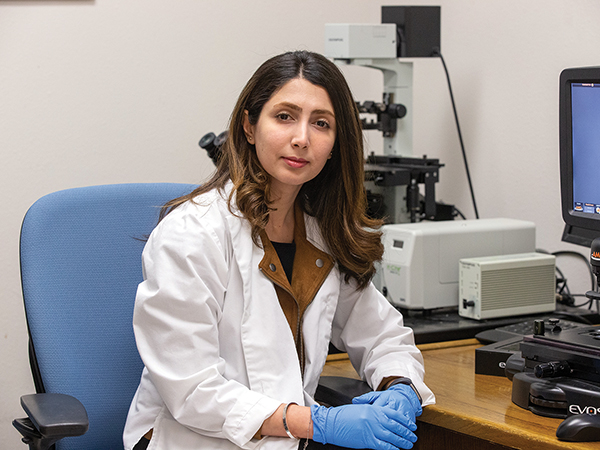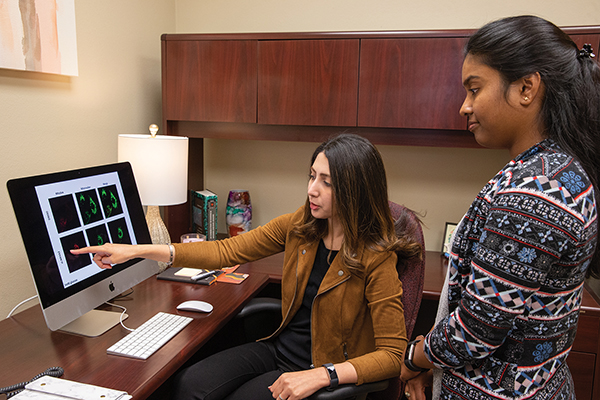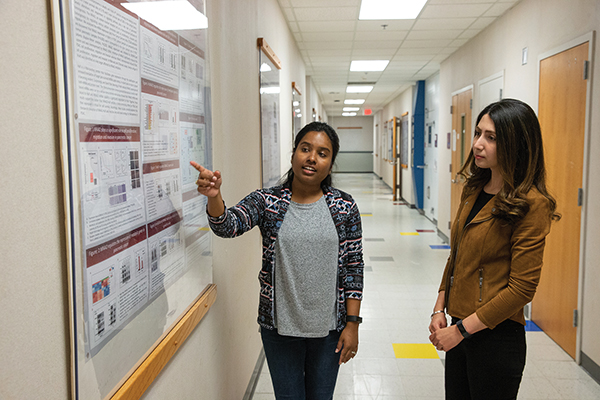Growing Knowledge, Shrinking Tumors
Story by Justin Agan
An early interest in cancer research set Mahsa Zarei on a path to investigate treatments for rare and genetically linked conditions.

Ask most 12-year-old children what they want to be when they grow up and you are likely to get a variety of answers ranging from professional athlete to astronaut.
While doctor or scientist might be on that list as well, it is doubtful you would hear something as specific as cancer biologist.
Mahsa Zarei, Ph.D., however, was one of those rare children.
A Young Passion
When Zarei was 12 years old, she watched two of her close aunts fight cancer. One aunt benefited from early diagnosis and treatment; the second passed away.
Throughout this ordeal, Zarei’s mind raced with questions: How could she help her aunts? What kind of cancer did they have? What were the treatments?
As a result, she became an avid student of cancer, devouring cancer biology books.
“At 12, I wanted to know, what is cancer and what’s happening with the cancer?” Zarei recalls. “I learned most of the treatments for different types of cancer.”
Zarei’s interest in this career path never wavered.
She earned her undergraduate degree in medical bio-technology and her Ph.D. in cancer biology before accepting a postdoctoral research scientist position at the Sidney Kimmel Cancer Center in Philadelphia.
In 2016, she was the lead author on a study about pancreatic cancer and its ability to survive in the nutrient-poor conditions of the pancreas. The survivability of pancreatic cancer in such poor conditions has also seemed to translate to its resistance of current chemotherapy treatments.
“It’s like a cactus in a desert,” Zarei explains, “without any nutrients, but it’s still growing and aggressive.”
Zarei and her co-researchers found that one of the key proteins, HuR, allowed the cancer to survive in the nutrient-poor microenvironment of the pancreas. It also gave the cancer a resistance to chemotherapy drugs.
What Makes Cancer Tick
As the well-known Sun Tzu quote advises, “Know the enemy and know yourself, you need not fear the result of a hundred battles.”
Zarei has followed this advice in her research by knowing her enemy.
Cancer, in one of the broadest definitions of the term, refers to diseases that cause abnormal cells to divide without control and can invade nearby tissues, according to the National Cancer Institute.

Most know that there are many different types of cancer caused by any number of things or underlying conditions. Doctors and researchers have spent decades, even centuries, fighting cancer in all its forms.
Previous treatments, like chemotherapy, concentrated on killing the cancerous cells, but more recently, there has been a push to discover new ways of fighting it.
For the better part of her career, Zarei took the approach of figuring out how different types of cancer worked at a very basic level. By understanding the different pathways and processes that allow these cancers to live and grow, she can understand how better to fight them at that basic level.
After leaving the Sidney Kimmel Cancer Center, Zarei joined Harvard Medical School as a research scientist fellow. There, while working at the Brigham and Women’s Hospital, she learned about a pair of fraternal twins, one of whom had tumors in the kidney; no one could determine why these tumors were occurring.
“That’s why I worked so hard to try and understand her disease better and to come up with something,” she said.
After conducting genetic screening, Zarei’s lab found that the girl had a rare genetic disease that causes tumors that can affect the brain, kidneys, lungs, and heart. A mutation in a protein complex called tuberous sclerosis complex (TSC) is what causes the tumor growth.
In normal cells TSC1 and TSC2 help inhibit, or stop, another protein complex called mTORC1. The girl’s tumor cells lacked TSC2, so mTORC1 was hyper-activated. This caused the out-of-control division of cells and the growth of the tumor.
After finding the pathway involved in the rare genetic disease, Zarei and her co-researchers looked for ways to interrupt that pathway. They found a drug called THZ1 that was being used for different cancer types, including breast and ovarian cancer.
When tested on TSC-deficient cells and normal cells, THZ1 selectively targeted the TSC-deficient cells and caused them to die, but left healthy cells alone.
The established treatment for this disease is a drug called rapamycin. Rapamycin and drugs similar to it, commonly called rapalogs, reduce tumor size while the patient is taking the drug. However, as soon as the treatment ends, the tumors begin to grow again, which means that patients would have to remain on the drug indefinitely.
Zarei’s research found that THZ1 not only reduced tumor size, but it prevented re-growth of the tumors after stopping treatment. The U.S. Department of Defense now funds this study, and Cyrus Pharmaceutical Company has begun the first clinical trials of a derivative of THZ1.
“We are hoping that in the near future we can use this with a TSC patient,” Zarei said.

Aggieland Bound
In 2018, Zarei moved to College Station with her husband, who had accepted a position in the Texas A&M University College of Engineering.
Zarei was then recruited by the Texas A&M College of Veterinary Medicine & Biomedical Sciences’ (CVM) Department of Veterinary Physiology & Pharmacology (VTPP).
“The evaluation of her cancer research program by the faculty in our department identified Dr. Zarei as a rising star and drove our intense interest in getting her to Texas A&M,” said VTPP department head Dr. Larry Suva. “She is an asset to our department, college, and university.”
Suva describes Zarei as a “role model for the energy and focus needed for faculty to succeed in academia.”
Since arriving at Texas A&M, Zarei has continued her research on TSC. In September, she published a paper on her research in the Journal of Experimental Medicine.
She has also renewed her research in pancreatic cancer with renowned cancer researcher Dr. Stephen Safe, also in VTPP. Together, they hope to find a new treatment that will reduce pancreatic cancer’s tolerance of its harsh microenvironment and chemotherapy.
Zarei is hopeful they will be able to publish their findings soon.
“Dr. Zarei has been great to work with,” Safe said. “She will be a prime candidate for a full faculty position.”
Zarei has turned an adolescent passion into a thriving career. In the future, she wants to continue finding answers in the lab that translate to the patients’ beds.
While she has mentored and taught students in her lab, including undergraduate researchers like Rachel E. Yan, one of the co-authors on Zarei’s most recent journal publication, she also hopes to return to the classroom soon, to pass on what she has learned.
Zarei wants to teach undergraduate and graduate classes, and “maybe a cancer biology class, if that’s possible.”
“My future goal is to be a well-known scientist, working on rare diseases and pancreatic cancer,” Zarei said. “I’m really passionate about having students to work with.”
###
Note: This story originally appeared in the Spring 2020 edition of CVM Today.
For more information about the Texas A&M College of Veterinary Medicine & Biomedical Sciences, please visit our website at vetmed.tamu.edu or join us on Facebook, Instagram, and Twitter.
Contact Information: Jennifer Gauntt, Director of Communications, Texas A&M College of Veterinary Medicine & Biomedical Sciences; jgauntt@cvm.tamu.edu; 979-862-4216


